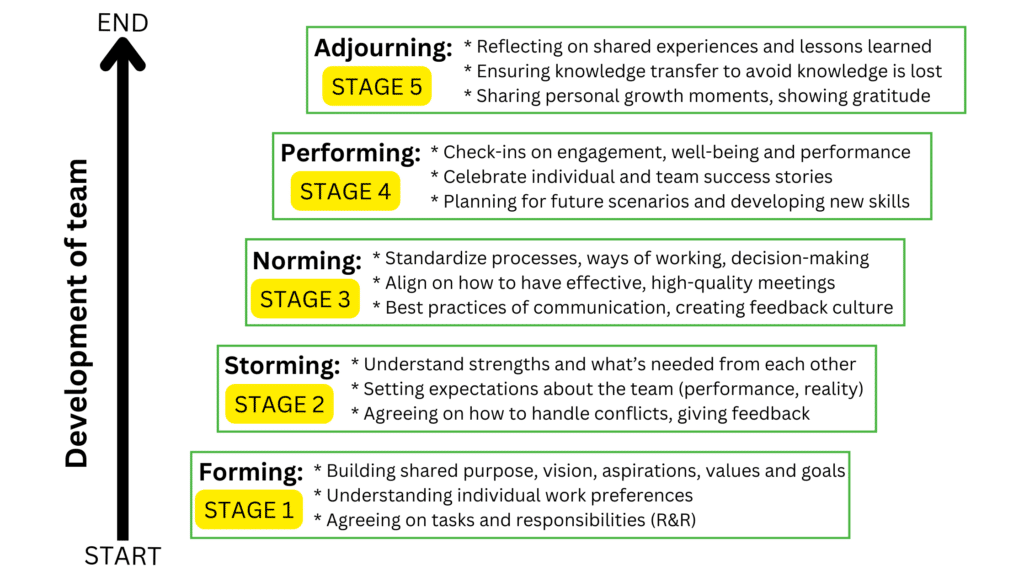Building, molding and shaping high performing teams is truly fascinating.
Whether in sports, the military, or corporate contexts, the dynamics of high-performing teams captivate us all.
Research shows that only 1 in 5 teams are high-performing[1], making such teams rare and exceptional[2]. In his article Do All Teams Need to be High Performing?, PhD and I/O Psychologist Gordon Curphy from Curphy Leadership Solutions argues that achieving and maintaining high performance is incredibly challenging[2]. Therefore, for most groups and teams, improving efficiency and effectiveness are more realistic and attainable goals[2].
Curphy points out that becoming a high-performing team may be an illusory goal for most because they often don’t invest the same care in team member selection or afford the same practice-to-perform ratio as many high-performing teams do[2].
He raises an excellent point.
The context, the selection of team members, and the effort put into practice all affect the feasibility of building a high-performing team.
So, for most groups, it’s more valuable to aim for better efficiency and effectiveness to achieve their objectives and organizational results.
High performance should be seen as a journey rather than a destination. It’s about continuous improvement.
Team Coaching is one of many interventions that can help in building high-performance teams.
In this blog article, we’ll explore high-performing teams. Although they are rare, their journey can still inspire you on your own team development journey and leadership growth.
Let’s dive in.
Groups and Teams.
The terms “Group” and “Team” are often used interchangeably in organizations, but they refer to different constellations.
Clarifying these terms will help when discussing different stages of team development.
Here’s one way to distinguish between a group and a team[3]:
- Group: Members focus on individual goals and accountabilities. Group members don’t take responsibility for results other than their own, as individual accountability is most important.
- Team: A small number of people with complementary skills who are committed to a common purpose, set of performance goals and approach for which they hold themselves mutually accountable.
In essence, a Team shares a common purpose and works together to achieve both individual and collective goals, holding each other accountable for the results.
A Group, on the other hand, focuses solely on individual goals and accountabilities.
Teams are critical for organizations to achieve results. But what is the ideal team size?
The answer depends on several factors, such as the task complexity, context, team composition and manager quality.
Research on optimal team sizes is not conclusive, generally suggesting 5 to 12 members, though some studies show that 5-9 team members is best[4].
Wharton management professor Jennifer S. Mueller found that teams larger than 5 team members often experience diminishing motivation[4]. Her research shows that individuals in larger teams perform worse than individuals in smaller teams[5].
Further research suggests that teams of 4-6 people often excel at most tasks[6]. The oft-cited research on the Effects of size and task type on group performance and member reactions by J.R. Hackman and N. Vidmar narrows this number to 4.6 people[6].
Larger teams can face challenges due to increased coordination, communication and interactions needed.
So, smaller teams of 4-6 people seem to be a good rule of thumb for high performance, depending on the factors mentioned.
Next, let’s look at the different stages of team development.
Tuckman’s Team Development Stages.
Have you ever found it challenging to develop and maintain high team performance?
You’re not alone — it can indeed be challenging. All teams go through various stages of team dynamics, making it crucial for you as a leader to understand and manage these shifts to guide your team towards better performance.
Bruce Tuckman’s 5-stage team development theory offers a valuable framework to break this process down.
As shown in Figure 1, teams transition through five different stages: forming, storming, norming, performing and adjourning.

- FORMING — Team is established:
→ Team meets for the first time
→ Team members get acquainted
→ Team is in an orientation phase
↳ Team establisment is in progress (forms) - STORMING — Embracing differences:
→ Team experiences different behaviors and ways of working
→ Tension, competition and conflicts
→ Positioning happens in the team
→ Performance temporarily dips
↳ Team is in a state of friction
↳ This is key to build high performance long-term - NORMING — Building unity:
→ Conflict resolution and mutual norms
→ Unity, trust and psychological safety emerge
→ Clarity on roles & responsibilities created
→ Strengthened collaboration
↳ Team performance improves - PERFORMING — high performing team:
→ Well-established team cooperation
→ Strong team cohesiveness created
→ Team is now having its highest performance (high-performing team)
↳ Team members commit to decisions
↳ Team keeps each other accountable for performance standards - ADJOURNING — Tasks completed:
→ Team has achieved its results (tasks)
→ Team may be dissolved or re-organized (team members may leave or join)
↳ Temporary nature of team and transition
↳ Team undergoes phase of mourning
Using data, such as surveys, to guide your approach to building teams is valuable.
It helps you understand how well your team is performing across different factors and stages. These inputs can inform your development interventions, like workshops and other activities.
In the next part, let’s draw inspiration from a brand new book I read over the summer: From Forming to Performing: Your Team Performance Playbook by Cary Bailey-Findley[9].
He is the brain behind Healthy Performance Culture Consulting and his book builds directly on Tuckman’s team development stages.
From Forming to Performing.
From Forming to Performing: Your Team Performance Playbook (Figure 2) is a book tailored for leaders, HR professionals and team coaches at all levels to help master Tuckman’s team development stages[9].

The book serves as a playbook, featuring 25 proven workshops and activities to inspire and facilitate team development.
Whether you read it from beginning to end or use it as a reference based on your team’s needs, it offers valuable insights[9].
Each chapter corresponds to one of Tuckman’s stages, providing an overall description and around five workshops or activities for each stage that you can facilitate with your team.
Here’s a table listing each stage and the associated activities and workshops from the book[9]:
| Forming: → Shared vision board → Role clarification workshop → Values alignment → “How I work” presentations → Team purpose workshop |
| Storming: → “How we handle conflicts” workshop → Expectations vs reality discussion → “What I need from you” discussion → Practicing impactful feedback → Strengths showcase |
| Norming: → Process mapping workshop → Our meeting etiquette rules → Our communication best practices → Our framework for making decisions → Team retrospectives |
| Performing: → Team health checks → Success story showcase → Autonomous goal setting → Future scenario planning → Skill swap workshop |
| Adjourning: → Farewell coffee → Knowledge transfer workshop → Reflection session → Digital time capsule → Gratitude letters |
The activities range from building understanding and trust to implementing accountability measures and feedback mechanisms to keep improving.
Below in Figure 3, you’ll find an overview capturing the focus areas for the activities and workshops for each stage from the book, that I created.

I enjoyed reading the book and found it to be a practical source of inspiration with easily implementable activities.
The book’s activities help build an understanding of each team member’s preferred ways of working, personal values, communication preferences, strengths and areas where they need support and development.
This understanding fosters diversity and contributes to building shared team purpose, vision, values and goals.
I recommend giving the book a read for yourself, hopefully you will also find inspiration for team building.
P.S. What are your best and worst examples of team building experiences?
References.
[1]Nilsen, D. and Curphy, G. (2022) It’a Better to be Psychologically Safe Than Sorry. Available at: Talent Quarterly (talent-quarterly.com). (Accessed 23 July 2024).
[2]Curphy, G. (2024) Do All Teams Need to be High Performing? Available at: Linkedin (linkedin.com). (Accessed 23 July 2024).
[3)Katzenberg, J. R. and Smith D. K. (1993) The Discipline of Teams (March-April). Harvard Business Review. Available at: Harvard Business Review (hbr.org). (Accessed 23 July 2024).
[4]Klein, K. (2006) Is Your Team Too Big? Too Small? What’s the Right Number? Wharton School of the University of Pennsylvania. Available at: Knowledge at Wharton (knowledge.wharton.upenn.edu). (Accessed 23 July 2024).
[5]Mueller, J.S. (2012) Why individuals in larger teams perform worse. Organizational Behavior and Human Decision Processes, 117(1), pp. 111-124. Available at: ScienceDirect (sciencedirect.com). (Accessed 23 July 2024)
[6]Hackman, J.R. and Vidmar, N. (1970) Effects of Size and Task Type on Group Performance and Member Reactions. Sociometry, 33(1), pp. 37-54. Available at: American Psychological Association (psychnet.apa.org). (Accessed 23 July 2024)
[7]Tuckman, B.W. (1965) Developmental sequence in small groups. Psychological Bulletin, 63(6), pp. 384–399. Available at: American Psychological Association (psychnet.apa.org). (Accessed 23 July 2024).
[8]Tuckman, B.W. and Jensen, M.A. (1977) Stages of small-group development revisited. Group and Organization Studies, 2(4), pp. 419-427. Available at: American Psychological Association (psychnet.apa.org). (Accessed 23 July 2024).
[9]Bailey-Findley, C. (2024) From Forming to Performing: Your Team Performance Playbook, Healthy Performance Culture, Denmark: pp. 1-241.

